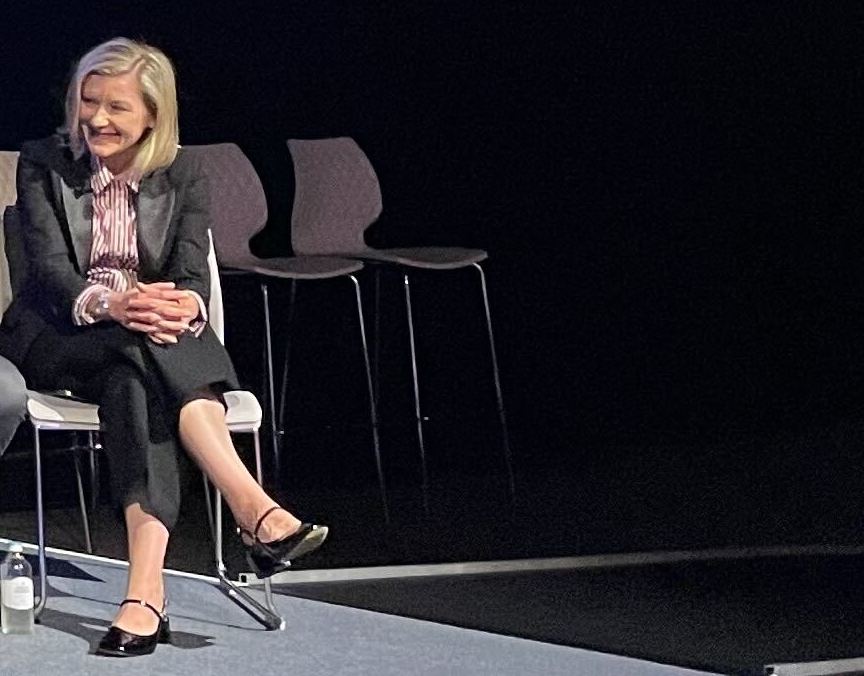
Governments across Australia are nearing consensus on “core areas of consistency” for how they approach generative AI and fold it into “business-as-usual” operations.

DTA’s Lucy Poole at the Microsoft AI Tour event.
A composite picture of collaborative efforts both inside the federal government, and between the federal, state and territory governments, has emerged over the past week via senate estimates and the Microsoft AI Tour event in Sydney.
A consistent theme is a desire among governments not to “start from scratch” or to continue developing separate sets of guidance on AI use in government settings, given the common ground that exists across jurisdictions.
What that common ground looks like isn’t final, but the focus is narrowing to a handful of key areas, DTA’s general manager of strategy, planning and performance Lucy Poole told iTnews on the sidelines of the Microsoft event.
“[Federal, state and territory governments] are working to a consistent set of principles in the first instance, and I suspect what will happen is as we evolve and develop our understanding and our respective experience, we’ll be able to identify underneath those principles the core areas of consistency that we aspire and strive to have,” Poole said.
“Can I tell you what those things are just yet? No, I can’t because we’re all on this journey, it’s all new.
“I suspect that those areas of consistency are going to be around accountability, governance and decision-making.
“There is [also] likely to be a whole lot of sharing around sourcing and how we procure. Managers that are across all governments are not going out and developing this generative AI, they’re buying it in. and so that is likely going to be an area where there is going to be consistency across the states and territories.”
At the federal level
On procurement, the DTA started to sound out the market at the end of last year for commercial offerings that could be offered on a whole-of-[federal] government basis.
A six-month trial of Microsoft 365 Copilot was also agreed around the same time, and is now underway.
Finance Minister Katy Gallagher said yesterday that “more than 7400 public servants across more than 50 government agencies are participating in the Copilot trial”.
“With participants ranging from Tourism Australia and the Bureau of Meteorology to the Department of Finance and IP Australia, it gives us an opportunity to better understand how generative AI can be used safely and responsibly in different types of work,” she said.
“Striking the right balance between innovation and risk is a priority.
“AI could help make routine tasks easier and simpler for public servants so they can focus on what really matters – the policy and delivery work that supports Australians.”
Poole said there was no need to “sell” participation in the Copilot trial to departments and agencies.
“We had agencies knocking on our doors saying, ‘We want in’. Not because of the hype – I think the starry-eyed thing [with generative AI] is kind of fading out. I think people are starting to realise there’s some real benefit to be able to take from this, real efficiencies,” Poole said.
The Copilot trial is essentially “an acknowledgement that agencies needed to start playing with this [generative AI capability] quickly so that we could start to experiment, make mistakes in a safe way, and ultimately build it into our everyday BAU.”
Poole noted that this aligned to a broader principle in federal government to “empower the system”.
“It’s not [about] controlling the system or doing it for the system,” she said.
“It’s enabling every agency across the system to be able to do what’s right for them within a certain set of parameters including shared accountability.”
Poole told the Microsoft AI Tour event that the federal government is “trying to figure out how we make the best of this new technology and at the same time protect ourselves against what we fully expect will be new areas of vulnerability for us.”
“We’re thinking about this in terms of a change management and people issue, as much as a tech issue,” Poole said.
“This is going to affect every single member of the public service.
“[But] the capacity for us to control the technology, to get it right before we head off on our journey does not exist. Instead what we’re trying to do is to figure out the areas of most importance to us – things like governance, assurance, and the core activity of how we make decisions – and how we deploy this to rapidly empower our staff to build the capability and confidence to use it in a way that … produces outstanding service delivery, and more importantly maintains the relationship and the trust between the government and all Australians.
“So, in essence, we’re doing exactly the same as everyone else, but there is an additional impetus on government to ensure that we are operating with a higher bar. We are working rapidly behind the scenes to do that.”
The DTA is not the only federal agency with AI oversight responsibility; the Department of Industry, Science and Resources (DISR) also has a role, with both agencies jointly leading an ‘AI in government’ taskforce set up in August last year.
One of the outputs of that taskforce is interim guidance for Commonwealth agencies around generative AI use.
While not as prescriptive as similar work by some states and territories – as revealed by iTnews late last year – Poole told the Microsoft event that the broad nature of the federal guidance was intentional.
“We used the ‘AI in government’ taskforce to be able to very quickly issue interim guidance to agencies about what they can and can’t do. Was it overly prescriptive? No, on the basis that this was still coming to light, we’re still discovering what this thing was and how we were going to optimise its use. But what it did was put a line in the land and it gave people assurances that there are going to be some no-go zones,” Poole said.
“As soon as we did that, it gave us the scope to be able to start thinking more broadly about what this means from a systems perspective, a sourcing perspective, a customer experience perspective etc.
“From that, we’ve been able to pull together a very detailed roadmap as to how we’re going to group this up.”
Poole told senate estimates last night that while there is a coordinated approach to adoption and knowledge-sharing in federal government, there isn’t necessarily a centralised whole-of-government register of all active use cases and trials of the technology.
“I think that would probably be an exercise that would be beyond the resources of the DTA,” she said.
Poole added that varying levels of maturity across the Australian Public Service with respect to applying AI is to be expected.
“We would consider that to be absolutely reasonable,” she said.
Ry Crozier attended the Microsoft AI on Tour in Sydney as a guest of Microsoft.











